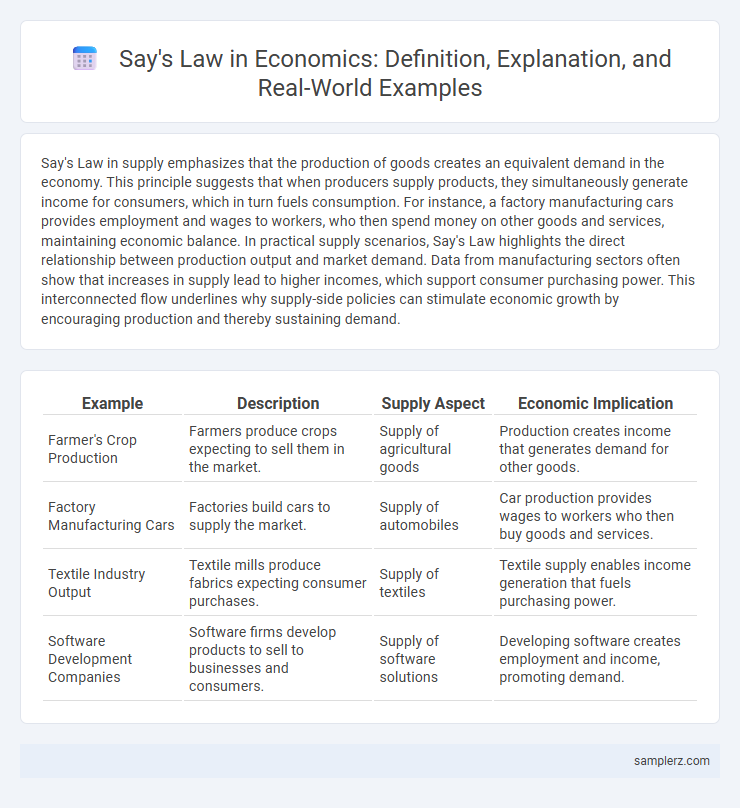Say's Law in supply emphasizes that the production of goods creates an equivalent demand in the economy. This principle suggests that when producers supply products, they simultaneously generate income for consumers, which in turn fuels consumption. For instance, a factory manufacturing cars provides employment and wages to workers, who then spend money on other goods and services, maintaining economic balance. In practical supply scenarios, Say's Law highlights the direct relationship between production output and market demand. Data from manufacturing sectors often show that increases in supply lead to higher incomes, which support consumer purchasing power. This interconnected flow underlines why supply-side policies can stimulate economic growth by encouraging production and thereby sustaining demand.
Table of Comparison
| Example | Description | Supply Aspect | Economic Implication |
|---|---|---|---|
| Farmer's Crop Production | Farmers produce crops expecting to sell them in the market. | Supply of agricultural goods | Production creates income that generates demand for other goods. |
| Factory Manufacturing Cars | Factories build cars to supply the market. | Supply of automobiles | Car production provides wages to workers who then buy goods and services. |
| Textile Industry Output | Textile mills produce fabrics expecting consumer purchases. | Supply of textiles | Textile supply enables income generation that fuels purchasing power. |
| Software Development Companies | Software firms develop products to sell to businesses and consumers. | Supply of software solutions | Developing software creates employment and income, promoting demand. |
Real-World Applications of Say’s Law in Modern Economies
Say's Law, which states that supply creates its own demand, is evident in modern manufacturing sectors where increased production capacity often leads to higher consumer spending and economic growth. For instance, Germany's industrial expansion post-World War II showcases how boosting supply through technological innovation and efficient production stimulated demand domestically and internationally. This principle underpins supply-side economics policies that emphasize reducing production costs to drive investment, employment, and overall market demand.
Case Studies: Say’s Law in Action
Case studies of Say's Law in action reveal how supply creates its own demand in various industries. For instance, during the Industrial Revolution, increased production of textiles led to expanded markets as workers' wages grew, fueling further consumption. Modern examples include tech manufacturing, where innovations and mass production stimulate demand through product availability and improved affordability.
Say’s Law and the Production of Consumer Goods
Say's Law emphasizes that the production of consumer goods generates an equivalent demand in the economy because income earned from manufacturing translates directly into purchasing power. By producing goods, firms pay wages, rent, and profits, which consumers then use to buy products, ensuring supply inherently creates its own demand. This principle explains how the supply of consumer goods drives economic equilibrium through balanced income and expenditure flows.
Say’s Law in Agricultural Markets: A Practical Example
Say's Law in agricultural markets illustrates that supply creates its own demand, as farmers produce crops that inherently generate demand through consumption and trade. For instance, a wheat harvest supplies food for both human consumption and livestock feed, stimulating related industries such as milling and baking. This cycle demonstrates how agricultural production drives economic activity by aligning supply output with the purchasing power of consumers.
The Role of Say’s Law in the Tech Industry Supply Dynamics
Say's Law posits that supply creates its own demand, which is evident in the tech industry as rapid innovation in hardware and software constantly generates new products that stimulate consumer interest and market expansion. Companies like Apple and Samsung drive supply by developing cutting-edge devices, leading to increased consumer spending and enabling continuous technological advancement. This cyclical relationship between supply innovation and demand growth highlights the critical role of Say's Law in shaping tech industry supply dynamics and overall economic progress.
Historical Instances Demonstrating Say’s Law
The Industrial Revolution exemplifies Say's Law through the rapid increase in production capacity driving economic growth by generating equivalent demand. In 19th-century Britain, expanded manufacturing output led to higher wages and consumption, validating the principle that supply creates its own demand. Similarly, post-World War II economic expansion in the United States demonstrated how increased industrial supply facilitated widespread consumer demand and rising living standards.
Say’s Law and the Automobile Industry Supply Trends
Say's Law, which states that supply creates its own demand, is evident in the automobile industry where increased production capacity often stimulates consumer interest and market expansion. For example, when car manufacturers introduce new models and ramp up production, it encourages complementary sectors like finance, insurance, and aftermarket services to grow, supporting broader economic activity. This supply-driven growth dynamic aligns closely with Say's Law by demonstrating how automobile supply trends can catalyze demand within the industry and related markets.
Say’s Law as Evidenced in E-Commerce Supply Chains
Say's Law, which states that supply creates its own demand, is evident in e-commerce supply chains where inventory availability directly drives consumer purchases. Efficient distribution networks and real-time stock management ensure that product supply aligns with fluctuating online demand, preventing overstock and stockouts. This dynamic supply responsiveness supports continuous market equilibrium in digital retail environments.
Say’s Law During Economic Booms: Supply Creating Its Own Demand
Say's Law during economic booms demonstrates how increased production capacity leads to higher employment and income levels, which in turn generate sufficient demand for goods and services. Businesses respond to rising consumer spending by expanding supply further, reinforcing economic growth and stabilizing the market equilibrium. This dynamic underscores the principle that supply inherently creates its own demand during periods of robust economic expansion.
The Impact of Say’s Law on Small Business Production and Growth
Say's Law posits that supply creates its own demand, encouraging small businesses to increase production with the expectation that goods will be sold. This principle drives entrepreneurial investment, fostering innovation and expanding product offerings to match market needs. As small enterprises grow, they contribute to economic development by generating employment and enhancing consumer choice.

example of Say’s law in supply Infographic
 samplerz.com
samplerz.com